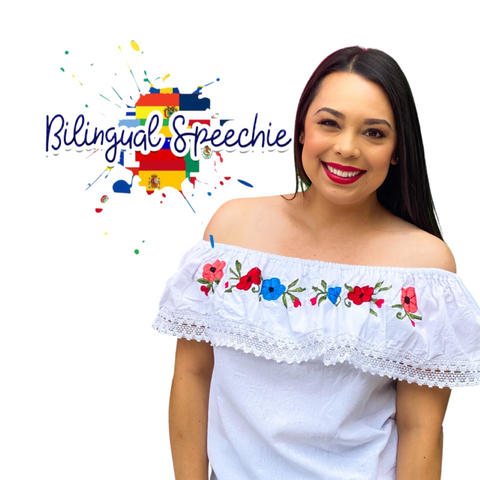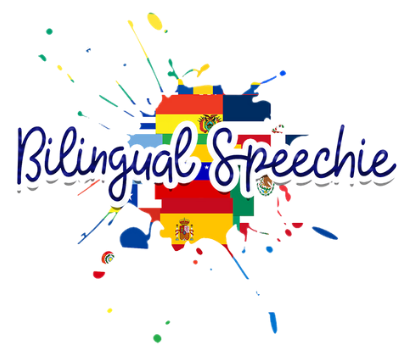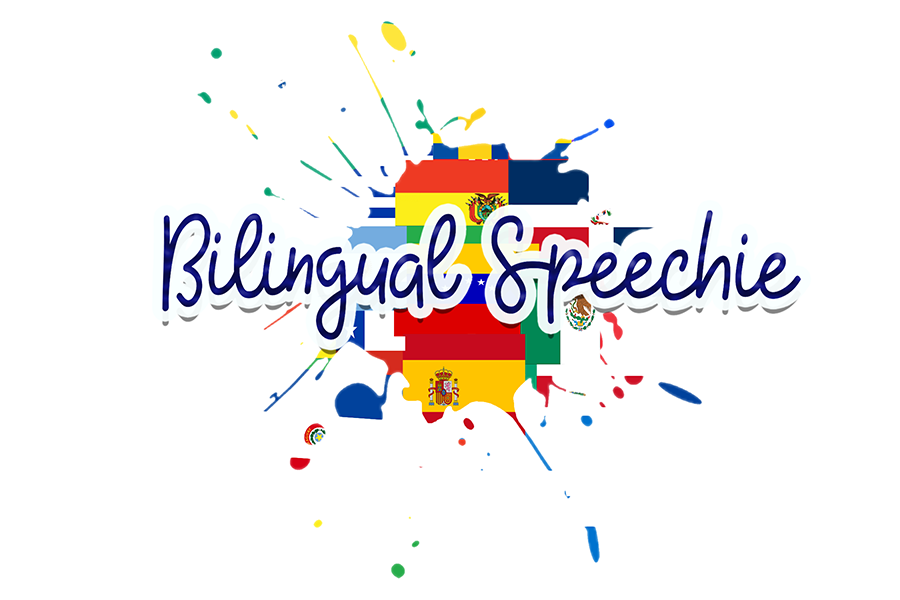by Liliana Diaz August 31, 2022 2 Comments
So you have a bilingual student on your speech caseload and you are unsure which language intervention should be in. Perhaps the student is exposed to (insert any language here) at home and is receiving English-only instruction at school. Questions you are probably wondering are: Should speech/language intervention be in the home language or the language of instruction? Should speech therapy be in the child's most dominant language? Should speech therapy be in both languages? But how do I target both languages in intervention? And will using both languages in intervention hinder the student's progress with therapy? These are all great questions and if you are wondering the answers then keep reading because the answers are below!
Often times, school-based SLPs are faced with the pressure of being told that speech therapy should only be in the language of instruction. The reason behind this idea is the underlying belief that the student should be able to access the academic curriculum and the only way to do this is by focusing on the language of instruction (most often times English). Yes, the student should be able to access the curriculum, but ELL academic supports should already be in place for the student in the classroom. Supporting the idea of focusing only on the language of instruction in speech therapy can have negative consequences on the bilingual student's language skills, family dynamic, cultural values, social-emotional learning and much more. Speech therapy should always support both languages for bilingual students and here's why.
Providing therapy in the home language is crucial for the child's social-emotional development, family dynamic and family ties. Therefore, ignoring the home language is doing a disservice to your students. According to Dr. Brian A. Goldstein, author of Bilingual Language Development & Disorders in Spanish-English Speakers "for immigrant children with family members who do not speak the community language, preservation of the home language is paramount for maintaining the intergenerational family connections and cultural links required for adequate social-emotional development."
Of course there is also the argument that speech therapy should be in the child's most dominant language because that's the child's strongest language, therefore, easier to work on which will lead to faster gains. However, this underlying belief discounts the second language and reinforces the idea that one language is "better" than the other. With this approach, we are unknowingly creating a language preference for the child which also leads to negative consequences as mentioned above.
It is natural to believe that intervention in the dominant language will be more effective if it builds on the child's existing skills however, this belief discounts the interactions that happen between both languages. After all, a bilingual student is not two monolingual students in one. A bilingual student will naturally have a certain set of strengths and skills in both languages. In addition, this belief reinforces the idea that language is constant across time and this simply isn't true. Bilingualism is fluid and a bilingual student's language proficiency can change over time depending on several factors (environment, exposure, use, etc.) Therefore, sticking to one language permanently during intervention will not always work.
The simple answer is YES! But keep in mind that supporting both languages does not necessarily mean always using both languages in a single session. It really depends student to student and according to Dr. Brian A. Goldstein, we need to be able to utilize a holistic and interactive view of bilingual development when planning the student's intervention goals.
There are two approaches that you can take when providing speech therapy to a bilingual student. The first is a bilingual approach which simultaneously directs attention to improving communication competency in both languages. This is done by ensuring that speech/language therapy goals include shared features between the both languages. For example, you might create an articulation goal for initial /k/ for your Spanish-English speaking student because initial /k/ exists in both languages. Another example is that you might create a language goal of plural -s for your Spanish-English speaking student because plural -s also exists in both languages.
The second approach is a cross-linguistic approach which focuses on the linguistic features that are unique to each language. In therapy, you might focus on non-overlapping features which may be at the sound level, meaning, structural level and/or even pragmatic level. An example at the sound level would be such as targeting trilled R in Spanish and vocalic R in English on separate occasions throughout the school year.
Absolutely not. Using both languages in intervention will only improve your bilingual student's communication skills which will lead to greater carry-over of the taught skill.
Questions? Comments? Let me know below :)
August 09, 2023
These are great tips thank you. Do you know where I can find good resources that outline all of the similarities and difference between Spanish and English such as the examples you get above with initial K and plural-s?
September 08, 2022
Languages are illogical and defy the rules, especially English. In my experience comparing and contrasting the different languages is essential. Social discourse is learned children to children faster than by teacher instruction but the understanding of differences in syntax, in sounds, etc need teacher clarification.
Are you teaching spoken English or are you teaching skills necessary to learn English by exposure?
Comments will be approved before showing up.
by Liliana Diaz December 14, 2023
by Liliana Diaz July 23, 2023
Have a client on your caseload that is demonstrating difficulty producing the CH sound? Perhaps you're a parent whose child is in speech therapy working on the CH sound? The CH sound can be a tricky sound to teach because it's hard to visually see what's going on inside the mouth when saying the sound. But no worries, here are some tips to help achieve that tricky CH sound.
by Liliana Diaz February 13, 2023 1 Comment

Who are we?
Bilingual Speechie LLC. is a small business dedicated to providing inclusive and engaging speech therapy resources and activities for bilingual children, parents, SLPs and educators.
Bilingual Speechie LLC promotes bilingualism and multilingualism by dispelling common myths, providing education on bilingual language development, and promoting heritage language maintenance amongst bilingual families.
About the Owner:
Liliana Diaz-Vazquez is a certified licensed bilingual speech language pathologist (SLP), currently practicing in Chicago, Illinois. She obtained her bachelor’s degree in communication disorders (2012) and her master’s degree in speech language pathology at Saint Xavier University (2014). She is a certified member of the American Speech-Language and Hearing Association (ASHA) since 2014, a member of the Illinois Speech and Hearing Association (ISHA) since 2014 and maintains licensure in the state of Illinois.
Liliana is a first-generation Mexican-American Latina, a small business owner, a full-time school-based SLP, & a bilingual parent, who takes pride in her roots, culture, & heritage language. She loves being able to share her experience as a Latina SLP, and a bilingual mom, as well as her culture & heritage language with the educator, SLP, and parent community.
Liliana Diaz-Vazquez has extensive experience working with the bilingual English and Spanish speaking population & multilingual population. She specializes in augmentative/alternative communication (AAC), bilingual language development and language delays/disorders in bilingual/multilingual children. She has also worked in the early intervention setting for several years where she gained vast experience working with interpreters and bilingual/multilingual families.
Liliana began creating digital bilingual resources and activities in 2014 out of need while working full-time in the school setting as a SLP. Liliana worked with many Spanish-speaking families and quickly realized that there were limited Spanish and bilingual speech therapy resources available for her students and their families. In addition, Liliana quickly became aware that there was a need for education about bilingualism and typical bilingual language development as many of the families she worked with had encountered misinformation about bilingualism. Liliana began developing resources and eventually started Bilingual Speechie LLC with the mission to provide education to SLPs and families about bilingualism, as well as provide inclusive and diverse materials for speech therapy in order to help bilingual families and SLPs gain access to appropriate bilingual materials for children with communication disorders.
Today Liliana currently works full-time in the Chicago public school setting as a lead bilingual SLP where she consults and collaborates with SLPs daily to help them understand how to assess and provide culturally and linguistically appropriate services for bilingual and/or multilingual students. She also runs her small business, Bilingual Speechie LLC, and is on a mission to expand and grow her business so that all SLPs, educators, and families can have access to inclusive, diverse, and bilingual resources in a variety of languages for speech therapy.
Professional Development:
Liliana has vast experience as a speaker/presenter and has presented at several conferences over the years. You can view all previous conferences and topics that Liliana has presented on here. Liliana is available to present on topics such as best practices when working with multilingual populations, bilingual speech/language assessment and treatment, goal writing with multilingual populations and much more. If you are interested in booking Liliana for a conference or event please don't hesitate to send an email at lilianadiaz@bilingualspeechie.com
 English
en
English
en
 English
en
English
en
 Español
es
Español
es


Liliana Diaz
Author